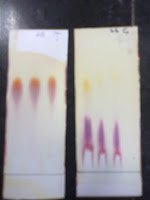Our Technical Director, Ned Dugan, recently participated in a  discussion about Thin Layer Chromatography with Ling Bei and Dave Lentz of EMD Chemicals and the editors of LCGC.
discussion about Thin Layer Chromatography with Ling Bei and Dave Lentz of EMD Chemicals and the editors of LCGC.
Here’s a couple of excerpts:
What developments have you the most excited or intrigued in TLC?
Dugan: There are two categories that come to mind. First, I’m excited to see TLC making a significant difference in people lives, whether that’s protecting people from counterfeit anti-malarial medication or helping law enforcement catch criminals through ink analysis.
The second category involves applications that a person just wouldn’t normally think about. For example, using TLC to determine the difference between diesel smokes (whether the smoke contains a potent carcinogen or not). That makes me wonder just how TLC is going to be applied in the next 5–10 years.
Bei & Lentz: Anything that will help spread the word that TLC does more than you think and that it can help solve a lot of modern problems.
Continued automation and software breakthroughs have allowed TLC users to control variables and achieve better reproducibility and faster results and to finally develop rugged, validated methods. Now it also allows them to interface with lab data and LIMS systems.
…
What are the pros and cons of using TLC in a food safety lab? How about in an environmental lab?
Dugan: The advantages of using TLC in food safety and environmental labs are the same as using TLC in any lab. It is an easy-to-use method that can accommodate multiple samples and standards simultaneously. It is inexpensive and affords (pun intended) the analyst a snapshot into the constituents of a sample matrix in a way that other forms of chromatography simply can not provide.
The downside of TLC is that it is only one tool in the toolbox. One tool won’t fix all problems. It takes the collection of tools to effectively manage an analytical laboratory.
Bei & Lentz: Common advantages of TLC for both types of labs include little or no cleanup even for some “dirty” samples, multiple parallel separations under identical run conditions for high throughput, and very much lower initial and consumable costs compared to HPLC or GC. Plus, every component of even extremely complex food or environmental samples is somewhere on the developed TLC plate and can be isolated using specific visualization or indicator reagents, then scraped off and recovered for further analysis or purification.
…
What do you hope and expect to see in the future for TLC?
Dugan: What I expect to see is TLC being used more often for the versatile tool that it is in multiple fields of science. I hope to see TLC applied to even more areas that would make a significant difference in the world. For example, helping to develop and test potential alternatives to fossil fuels or developing new methods for cleaning water supplies.
You can read the complete discussion here.



 discussion about Thin Layer Chromatography with Ling Bei and Dave Lentz of EMD Chemicals and the editors of LCGC.
discussion about Thin Layer Chromatography with Ling Bei and Dave Lentz of EMD Chemicals and the editors of LCGC.

 several great people who use chromatography on a regular basis.
several great people who use chromatography on a regular basis.